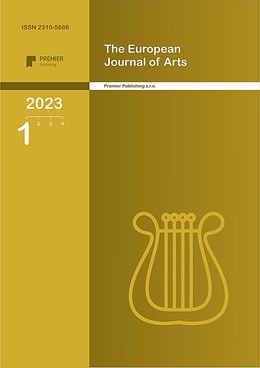THE ROLE OF TECHNOLOGY IN MODERN UZBEK ANIMATION AND ISSUES IN PERSPECTIVE
Authors
Haydarova Nigora Tokhirjonovna

Share
Annotation
The purpose of the research: This article analyzes the creation of Uzbek animated films in various technologies, their influence on the artistic image created in modern technologies, starting with the first puppet cartoons.
Research methods: analysis, synthesis, observation, comparison, conversation.
Research results: Uzbek animation is interpreted in the above technologies, the development of which can be cited as follows. Puppet technology took the lead among technology until independence. Later, the drawing became richer with the film, and as a result of the addition of perekladka technology, the type of technology increased. At the beginning of the years of independence, perekladka technology developed, resulting in the 2000-2005 creation of films mainly on this technology. In these years, although the drawing began to create films in computer technology, but until the adaptation to the new technology, films were created mainly on perekladka technology. In the meantime, works were also created on plasticine technology. But the reason for the presence of specific complex processes of plasticine material was not created much work in this technology. From 2006, the entire drawing was switched to computer technology, and from 2010-to three-dimensional computer technology.
Practical application: The following recommendations on the development of technologies in Uzbek animation can be cited: 1. Animation studio provides the necessary equipment for puppet, plasticine, perekladka films, creating a modern creative environment and conditions, combining several technologies – that is, creating films that embody traditional and modern animation technologies; 2. Creation of a children's feature film with the participation of the heroes of the best works of the Uzbek multiplier and live actors; 3. The competition should be strengthened by the fact that the creators of the state studio switched to the creation of films in three-dimensional, private studios in two-dimensional technologies.
Keywords
Authors
Haydarova Nigora Tokhirjonovna

Share
References:
1. N.S. Kurkova. The Alphabet of animation. “Yurayt". Moscow. 2019.
2. D.V.Velinsky. The technology of the cartoon production process in the shifting techniques. Methodical manual. “Search". Novosibirsk. 2010.
3. M.A.Stepanova. Computer special effects based on the material of Hollywood cinema of the last decade of the XX century. Abstract PhD thesis. Moscow. 2005.
4. The wisdom of fiction. "Art" Moscow. The compiler and author of the introductory article S. V. Asenin. 1983.
5. E.A.Popov. Animation work: typology and evolution of figurative means. Abstract of the candidate. diss. St. Petersburg. 2011.
6. N.T. Khaydarova. Problems of interpretation and development of classic works in Uzbek animation art.// European Journal of Arts. № 1. 2020. – Р. 157-162.
7. N.T. Haydarova. Special effects in modern Uzbek animated films. // European science review. № 3-4. 2021. March-April. - P.20.
8. N.T. Haydarova. Problems of Character Creation in Animation Films of Uzbekistan. // Webology, / Volume 19, Number 1, January, 2022. – P. 1587.


